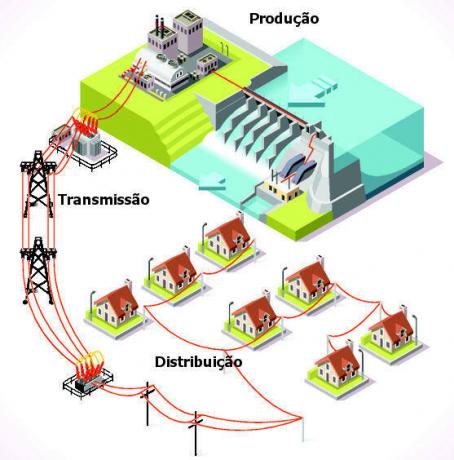THE electricity distribution in Brazil it is made up of a complex network of elements whose purpose is to conduct energy from the place of production to the place where it will be consumed. This system connects generating units, transmission and distribution routes and final consumers of the electricity.
This network was not always integrated. In the past, before the intense industrialization process in the Southeast region of the country, transmission and distribution lines were isolated and aimed at meeting local needs. However, the continental dimension of Brazil, the urbanization, a industrialization and the increased demand for electricity in some specific regions, such as the South and Southeast, motivated the integration of the electricity system in the country. Another important factor for this need for integration was that, in many cases, energy production – largely from hydroelectric origin -, was not located close to the places of greatest consumption, such as large urban centers and regions industrial.

The distribution of electricity in Brazil involves processes of production, streaming and distribution to the end consumer
At energy distribution companies (public or private) are responsible for the delivery of energy and, as with the transmission system, the distribution consists of conductor wires, transformers and measurement, control and protection equipment for networks electrical devices. The distribution system is much broader and more ramified than the transmission system, as it aims to reach the homes and businesses of all final consumers.
Do not stop now... There's more after the advertising ;)
The composition of the distribution networks has high, medium and low voltage lines. The power of distributed and delivered energy can be divided into:
primary electrical networks - medium voltage distribution networks that, in addition to the distribution role, serve medium and large companies and industries.
secondary electrical networks - low voltage distribution networks serving residential consumers, small commercial establishments and public lighting.
Brazil currently has around 80 million Consumer Units (UC) (energy delivery point with individual metering and corresponding to a single consumer). Most Consumer Units (85%) are residential, however, industry is responsible for 35% of electricity consumption in the country.
The energy transmission and distribution networks in Brazil followed the historical trajectory of the urbanization and industrialization process. The largest urban centers and industrial regions in the country are the largest consumers of electricity. In this sense, the infrastructure of the transmission and distribution networks was directed to these spaces.
By Amarolina Ribeiro
Graduated in Geography
Would you like to reference this text in a school or academic work? Look:
RIBEIRO, Amarolina. "Distribution of electricity in Brazil"; Brazil School. Available in: https://brasilescola.uol.com.br/geografia/distribuicao-energia-eletrica-no-brasil.htm. Accessed on July 27, 2021.

